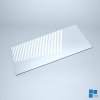General description
Glass ceramics is characterized by an exceptionally low coefficient of thermal expansion. Its delicate structure of the surface is typical for the process of glass rolling. In the production process there may occur slight heterogeneities (e.g. gas inclusions). They are covered by quality control and do not affect negatively the functionality or usability of the product.
Owing to its exceptionally low thermal expansion, ceramic glass is resistant to considerable fluctuations of temperatures (temperature change and difference on the surface and inside the glass panel).
Working
Ceramic glass can be worked mechanically by means of all methods applied to glass working (e.g. drilling). It is especially suitable for glass panels for room heating units (heaters and fireplaces).
Resistance
The surface of ceramic glass panels used in heaters is extremely survivable. When used in critical conditions (e.g. with high content of sulfur in combustible material there may occur tarnishing of glass) before starting to use one should conduct practical tests.
Thermal data
An average coefficient of thermal linear expansion: (20-700 ºC)
α (20-700) = (0,0 ± 0,3) · 10-6 K-1
Resistance to difference in temperature (TUF)
Resistance to difference in temperature (TUF) determines an ability of a glass panel to withstand the difference in temperatures between the hot center of a glass panel (heated side) and the cold edge of a glass panel (room temperature).
The TUF value is calculated by means of a standard method. The TUF value is a difference (in K) between the maximum temperature of the hot glass panel surface measured at its center and the temperature of the cold edge of a glass panel (room temperature). If it is exceeded, there may be cracks caused by thermal stresses.
Approximate TUF values for applications in which a glass panel crack is not dangerous (surfaces in a state typical for average use conditions):
- With short-term loads (100h): TUF = 700K
- With long-term loads (≥100h): TUF = 650K
Resistance to sudden changes of temperatures (ASF): Resistance to sudden changes of temperatures ASF of glass ceramics determines an ability of a glass panel to withstand a thermal shock caused by pouring cold water over a hot glass panel.
Due to nearly zero thermal linear extensibility, the thermal shock brought about by pouring cold water causes only slight stresses. Therefore, ceramic glass resistance to sudden changes of temperatures is limited exclusively by the highest temperature of its operational use.
The highest temperature of operational use:
- with short-term loads (total 100h): Tmax=750 ºC
- with long-term loads (total ≥ 100h - 10.000h): Tmax=680 ºC
The above highest temperatures of operational use apply only when the afore-mentioned TUF value are observed.
Impulse and dynamic strength of ceramic glass panels depends on the way of mounting, dimensions and thickness of a glass panel, the sort of impact load and many other factors.
Assembly and use
To ceramic glass panels apply the same conditions of use and assembly as to other products made of glass.
While determining the dimensions of frames and glass panels one should take into account various coefficients of thermal expansion as well as possible work tolerances of glass panels and materials used for frames.
If, for constructional reasons, it is necessary to place a glass panel in a frame, one should observe that the load is evenly distributed on the whole surface of the glass panel under the frame (so that the load does not affect the points only).
The frame in which the glass panel is to be fitted cannot be warped. If it is not possible to avoid slight twisting of the frame, then an appropriate permanently flexible seal should be used, which will prevent from transferring the warp onto the glass panel.
Direct contact of glass ceramics with metal should be avoided (or with elements made of other hard materials). As a separator between glass ceramics and metal we recommend permanently flexible, heat resistant materials, such e.g. cords and seals made of mineral wool, tapes made of aluminosilicate and others.
Cleaning and maintenance
Because surface changes may be the result of a way of cleaning, we should use detergents designed for fireplace glass and follow the instructions for cleaning and care of glass panels for heaters made of ceramic glass. In no circumstances are we allowed to use scrubbing agents or other caustic agents.







